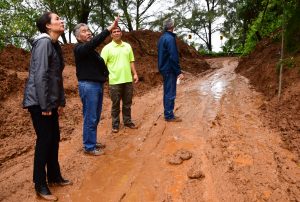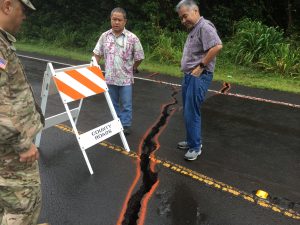From the governor: Protecting Hawai’i, today and tomorrow
Posted on May 30, 2018 in FeaturedFrom dealing with volcanic eruptions and devastating floods to pushing ahead on the state’s top priorities — the past few weeks have tested the resilience and determination of Hawai‘i’s citizens and the Ige administration. This edition highlights the governor’s focused approach to handling big issues and managing the threats of recent natural disasters.

Kaua’i staffer Carrice Gardner, Gov. Ige, state highways deputy Ed Sniffen and engineer Larry Dill check mudslide damage on Kuhio Highway.
Q. What do you want people to know about the recent natural disasters we’ve seen on Hawai‘i island, Kaua‘i and O‘ahu?
A. The state, county and federal government are committed to keeping the community safe and helping people rebuild their lives. Through emergency proclamations, we’ve moved quickly to secure state and federal aid for volcano and flood damage. It’s been so inspiring to see Hawai‘i’s people come together — from county personnel, Civil Defense and the National Guard to the Red Cross, Salvation Army and community volunteers — to help those in need. At the same time, we want people to know that many other parts of the islands are still welcoming visitors with their aloha spirit.
Q. What has made the disaster response to the Kīlauea eruption so challenging?
A. When I arrived at Leilani Estates in Puna, my first impression was this was a very different kind of eruption. Fissures were opening on roads in the middle of communities, and there was a lot less warning for residents. We don’t know if the eruption is going to last a few weeks or months, so that’s the challenge and the dilemma. We’re ready to execute plans, should roadways in Puna be lost to lava and air and sea evacuation become necessary. For many of the Puna folks, everything they own is on that property, and they don’t have many other options.

During the Kilauea eruption on Hawai’i island, the governor views cracks on a Puna district road with deputy director of Public Works Merrick Nishimoto.
Q. Why did you feel it was important to form a special response team to deal with risks to Puna Geothermal Venture (PGV)?
A. I thought it was imperative to take decisive action because residents were clearly concerned about the risks posed by the geothermal facility. The reality is there are active lava tubes under the plant and throughout the East Rift Zone. Currently, the facility is shut down, and we have taken steps to “quench” the wells to prevent a blowout of the wellheads. I wanted to be certain we had a quality team in place — led by Mayor Harry Kim, Tom Travis of the Hawai‘i Emergency Management Agency, and Talmadge Magno of Civil Defense — to evaluate the risks and work with PGV to determine the safest and most appropriate course of action.
Q. What is most significant to you about the 2018 legislative session?
A. The fundamental point to remember is that the Ige administration’s priorities have prevailed and there’s broad support for these programs. We have focused on strategies that have worked to increase affordable housing, reduce homelessness, expand education, improve the economy and protect the environment. All received funding support. Homelessness has declined two years in a row and the $200 million appropriated for affordable rental housing is catching up on requests we made earlier. I’m happy we received more funding for Early College, Hawai‘i’s Promise and watershed protection. We’ve been focused these past three years on serving the greatest, most pressing needs of the community, and I do believe our values and priorities reflect that.